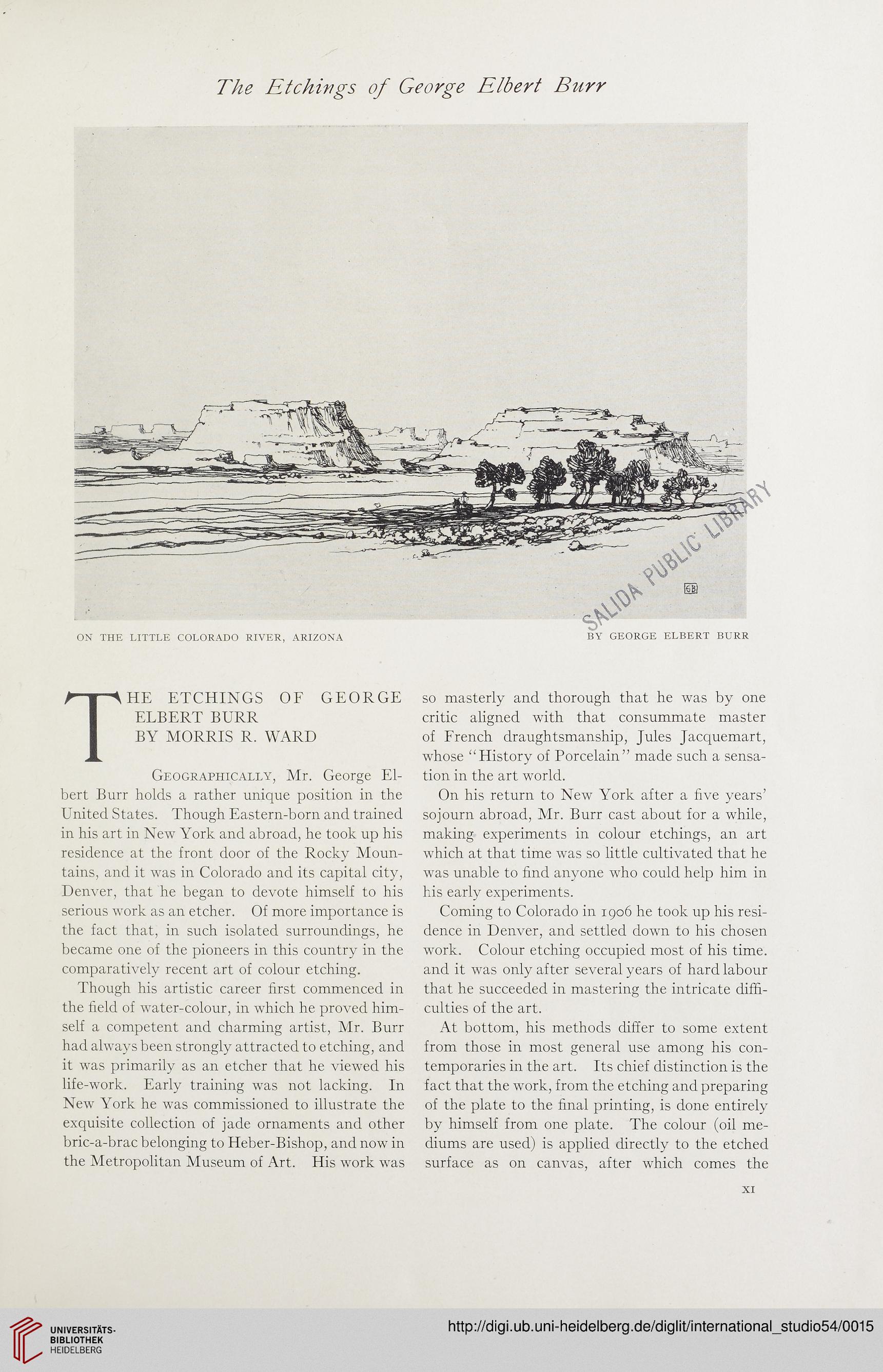The Etchings of George Elbert Bttrr
ON THE LITTLE COLORADO RIVER, ARIZONA BY GEORGE ELBERT BURR
The etchings of george
ELBERT BURR
BY MORRIS R. WARD
Geographically, Mr. George El-
bert Burr holds a rather unique position in the
United States. Though Eastern-born and trained
in his art in New York and abroad, he took up his
residence at the front door of the Rocky Moun-
tains, and it was in Colorado and its capital city,
Denver, that he began to devote himself to his
serious work as an etcher. Of more importance is
the fact that, in such isolated surroundings, he
became one of the pioneers in this country in the
comparatively recent art of colour etching.
Though his artistic career first commenced in
the field of water-colour, in which he proved him-
self a competent and charming artist, Mr. Burr
had always been strongly attracted to etching, and
it was primarily as an etcher that he viewed his
life-work. Early training was not lacking. In
New York he was commissioned to illustrate the
exquisite collection of jade ornaments and other
bric-a-brac belonging to Heber-Bishop, and now in
the Metropolitan Museum of Art. His work was
so masterly and thorough that he was by one
critic aligned with that consummate master
of French draughtsmanship, Jules Jacquemart,
whose “History of Porcelain” made such a sensa-
tion in the art world.
On his return to New York after a five years’
sojourn abroad, Mr. Burr cast about for a while,
making experiments in colour etchings, an art
which at that time was so little cultivated that he
was unable to find anyone who could help him in
his early experiments.
Coming to Colorado in 1906 he took up his resi-
dence in Denver, and settled down to his chosen
work. Colour etching occupied most of his time,
and it was only after several years of hard labour
that he succeeded in mastering the intricate diffi-
culties of the art.
At bottom, his methods differ to some extent
from those in most general use among his con-
temporaries in the art. Its chief distinction is the
fact that the work, from the etching and preparing
of the plate to the final printing, is done entirely
by himself from one plate. The colour (oil me-
diums are used) is applied directly to the etched
surface as on canvas, after which comes the
XI
ON THE LITTLE COLORADO RIVER, ARIZONA BY GEORGE ELBERT BURR
The etchings of george
ELBERT BURR
BY MORRIS R. WARD
Geographically, Mr. George El-
bert Burr holds a rather unique position in the
United States. Though Eastern-born and trained
in his art in New York and abroad, he took up his
residence at the front door of the Rocky Moun-
tains, and it was in Colorado and its capital city,
Denver, that he began to devote himself to his
serious work as an etcher. Of more importance is
the fact that, in such isolated surroundings, he
became one of the pioneers in this country in the
comparatively recent art of colour etching.
Though his artistic career first commenced in
the field of water-colour, in which he proved him-
self a competent and charming artist, Mr. Burr
had always been strongly attracted to etching, and
it was primarily as an etcher that he viewed his
life-work. Early training was not lacking. In
New York he was commissioned to illustrate the
exquisite collection of jade ornaments and other
bric-a-brac belonging to Heber-Bishop, and now in
the Metropolitan Museum of Art. His work was
so masterly and thorough that he was by one
critic aligned with that consummate master
of French draughtsmanship, Jules Jacquemart,
whose “History of Porcelain” made such a sensa-
tion in the art world.
On his return to New York after a five years’
sojourn abroad, Mr. Burr cast about for a while,
making experiments in colour etchings, an art
which at that time was so little cultivated that he
was unable to find anyone who could help him in
his early experiments.
Coming to Colorado in 1906 he took up his resi-
dence in Denver, and settled down to his chosen
work. Colour etching occupied most of his time,
and it was only after several years of hard labour
that he succeeded in mastering the intricate diffi-
culties of the art.
At bottom, his methods differ to some extent
from those in most general use among his con-
temporaries in the art. Its chief distinction is the
fact that the work, from the etching and preparing
of the plate to the final printing, is done entirely
by himself from one plate. The colour (oil me-
diums are used) is applied directly to the etched
surface as on canvas, after which comes the
XI




